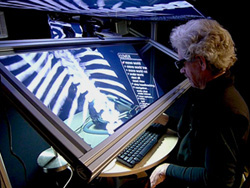HDTVs used for virtual reality project to "feel" 3D images


While the idea behind HUVR is not new, the latest technology makes it far more affordable and usable than previous versions that relied on CRTs and cost over $100,000. Instead, the UCSD researchers make use of a consumer Samsung 3D HDTV that uses active-shutter 3D technology to bounce images off the mirror (which a passive-3D solution cannot do). As a result, a fully outfitted HUVR unit costs a fraction of what its predecessors did and is far more mobile.
For the moment, HUVR is envisioned for commercial and academic uses like physicians manipulating an MRI image or archeologists examining ancient documents that are too delicate to physically handle. But you can be sure sometime in the future (though not in the near future) you'll be using something like this in your living room -- gamers especially will want such a setup to "hold" weapons or examine objects.
[Via UC San Diego news center]